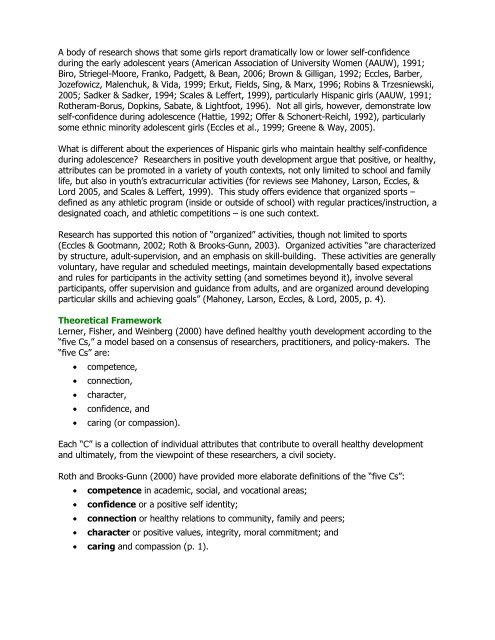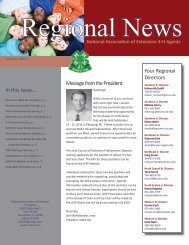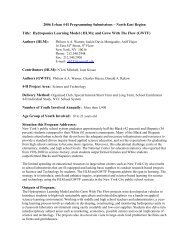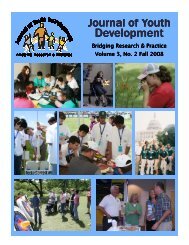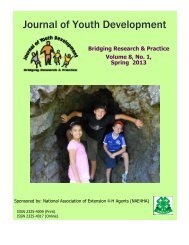<strong>Vol</strong>ume 3, Number 3, <strong>Winter</strong> <strong>2008</strong>Article 080303FA005Why Play Sports?How Organized Sports Participation Can Contributeto the Healthy Development <strong>of</strong> AdolescentHispanic GirlsMegan A. HorstAbt Associates, Inc.Abstract: This study addressed the research question, “What ismeaningful to Hispanic girls about their organized sports participationduring the first year <strong>of</strong> high school?” Purposeful sampling (Maxwell,1996) was used to select 15 9th-grade girls to participate in individualinterviews about their organized sport participation. Transcripts wereanalyzed via inductive coding. Findings showed that organized sports<strong>of</strong>fered Hispanic girls in this sample a venue for healthy youthdevelopment, including opportunities for the “5 C’s” – competence,confidence, connection, character, and caring (Lerner, Fisher, &Weinberg, 2000). This article highlights the salience <strong>of</strong> connection,caring, and competence in adolescent Hispanic girls’ organized sportsexperiences. Insights from girls’ narratives may help coaches and othereducators structure athletic programs to best meet the needs <strong>of</strong>Hispanic girls during adolescence (AAUW, 1991; Brown & Gilligan, 1992;Erkut, Fields, Sing, & Marx, 1996; Gil & Vazquez, 1996; Sadker &Sadker, 1994).IntroductionAdolescence is a time <strong>of</strong> inevitable change. Adolescents witness the physical maturation <strong>of</strong>their bodies, experience feelings <strong>of</strong> sexual desire, develop abstract ways <strong>of</strong> thinking, forge newrelationships and modify old ones, struggle to assert their independence yet maintainconnections, and grapple with who they are within their socio-cultural context (Elliott &Feldman, 1990). In the context <strong>of</strong> these multiple sources <strong>of</strong> change, researchers, clinicians,and parents have traditionally viewed adolescence as a turbulent time (Elliott & Feldman,1990).
A body <strong>of</strong> research shows that some girls report dramatically low or lower self-confidenceduring the early adolescent years (American <strong>Association</strong> <strong>of</strong> University Women (AAUW), 1991;Biro, Striegel-Moore, Franko, Padgett, & Bean, 2006; Brown & Gilligan, 1992; Eccles, Barber,Jozefowicz, Malenchuk, & Vida, 1999; Erkut, Fields, Sing, & Marx, 1996; Robins & Trzesniewski,2005; Sadker & Sadker, 1994; Scales & Leffert, 1999), particularly Hispanic girls (AAUW, 1991;Rotheram-Borus, Dopkins, Sabate, & Lightfoot, 1996). <strong>No</strong>t all girls, however, demonstrate lowself-confidence during adolescence (Hattie, 1992; Offer & Schonert-Reichl, 1992), particularlysome ethnic minority adolescent girls (Eccles et al., 1999; Greene & Way, 2005).What is different about the experiences <strong>of</strong> Hispanic girls who maintain healthy self-confidenceduring adolescence? Researchers in positive youth development argue that positive, or healthy,attributes can be promoted in a variety <strong>of</strong> youth contexts, not only limited to school and familylife, but also in youth’s extracurricular activities (for reviews see Mahoney, Larson, Eccles, &Lord 2005, and Scales & Leffert, 1999). This study <strong>of</strong>fers evidence that organized sports –defined as any athletic program (inside or outside <strong>of</strong> school) with regular practices/instruction, adesignated coach, and athletic competitions – is one such context.Research has supported this notion <strong>of</strong> “organized” activities, though not limited to sports(Eccles & Gootmann, 2002; Roth & Brooks-Gunn, 2003). Organized activities “are characterizedby structure, adult-supervision, and an emphasis on skill-building. These activities are generallyvoluntary, have regular and scheduled meetings, maintain developmentally based expectationsand rules for participants in the activity setting (and sometimes beyond it), involve severalparticipants, <strong>of</strong>fer supervision and guidance from adults, and are organized around developingparticular skills and achieving goals” (Mahoney, Larson, Eccles, & Lord, 2005, p. 4).Theoretical FrameworkLerner, Fisher, and Weinberg (2000) have defined healthy youth development according to the“five Cs,” a model based on a consensus <strong>of</strong> researchers, practitioners, and policy-makers. The“five Cs” are:• competence,• connection,• character,• confidence, and• caring (or compassion).Each “C” is a collection <strong>of</strong> individual attributes that contribute to overall healthy developmentand ultimately, from the viewpoint <strong>of</strong> these researchers, a civil society.Roth and Brooks-Gunn (2000) have provided more elaborate definitions <strong>of</strong> the “five Cs”:• competence in academic, social, and vocational areas;• confidence or a positive self identity;• connection or healthy relations to community, family and peers;• character or positive values, integrity, moral commitment; and• caring and compassion (p. 1).
- Page 2 and 3:
Winter 2008Volume 3 Number 3Editor
- Page 5:
Examining the Potential Unintended
- Page 8 and 9:
centered, multidisciplinary approac
- Page 10 and 11:
Volume 3, Number 3, Winter 2008Arti
- Page 12 and 13:
fostering skill learning and positi
- Page 14 and 15:
Table 1Participation in out-of-scho
- Page 16 and 17: ResultsOur analyses were conducted
- Page 18 and 19: watching TV, playing video games or
- Page 20 and 21: Accordingly, this research augments
- Page 22 and 23: Dotterer, A.M., McHale, S.M., & Cro
- Page 24 and 25: A Descriptive View of the 4-H Club
- Page 26 and 27: In this paper, the results of a cro
- Page 28 and 29: section is a set of statements that
- Page 30 and 31: Table 3Experience in the 4-H clubNo
- Page 32 and 33: significantly higher than Caucasian
- Page 34 and 35: p
- Page 36 and 37: This study focused only on the 4-H
- Page 38 and 39: Theokas, C., Lerner, J.V., Phelps,
- Page 40 and 41: Volume 3, Number 3, Winter 2008Arti
- Page 42 and 43: potential for reaching audiences, d
- Page 44 and 45: Putting Marketing Concepts into Pra
- Page 46 and 47: 2. Find out what others think about
- Page 48 and 49: Diem, K.G. (1994). What do youth li
- Page 50 and 51: Promoting Supportive Relationships
- Page 52 and 53: focused on youth-adult relationship
- Page 54 and 55: Conversely, more modern educational
- Page 56 and 57: perhaps most importantly, the effic
- Page 58 and 59: Organized youth programs, when stru
- Page 60 and 61: likely to internalize the positive
- Page 62 and 63: Ellis, J.M., & Caldwell, L.L. (2005
- Page 64 and 65: Schweinle, A., Meyer, D.K., & Turne
- Page 68 and 69: This study uses the “5 Cs” mode
- Page 70 and 71: ResultsIn this analysis 48 codes we
- Page 72 and 73: Table 3Inductive Codes Classified b
- Page 74 and 75: CompetenceCompetence in organized s
- Page 76 and 77: ecause of him (the coach)…. You d
- Page 78 and 79: practices and competitions, the gir
- Page 80 and 81: Eccles, J.S., & Gootmann, J.A. (Eds
- Page 82 and 83: Smoll, F.L., & Smith, R.E. (2002).
- Page 84 and 85: Volume 3, Number 3, Winter 2008Arti
- Page 86 and 87: The present work builds upon that o
- Page 88 and 89: MethodSample and Data CollectionAs
- Page 90 and 91: (scores ranging from 0 to 8) and a
- Page 92 and 93: Table 2Paired Sample T-tests Compar
- Page 94 and 95: Hypotheses 5 and 6 were tested by c
- Page 96 and 97: De Coverly Veale, D.M.W. (1987). Ex
- Page 98 and 99: Story, M., Neumark-Sztainer, D., Sh
- Page 100 and 101: Volume 3, Number 3, Winter 2008Arti
- Page 102 and 103: Cronbach’s Alpha Score For Youth
- Page 104 and 105: 12 to 18 years old. Fourteen of the
- Page 106 and 107: Therefore, there was a mixed relati
- Page 108 and 109: Youth respondents identified two ob
- Page 110 and 111: are developed through working in a
- Page 112 and 113: Seevers, B.S., & Dormody, T.J. (199
- Page 114 and 115: Volume 3, Number 3, Winter 2008Arti
- Page 116 and 117:
With the many opportunities that yo
- Page 118 and 119:
meaningfully reduced involving dedu
- Page 120 and 121:
StaffingXTime/Schedule X X XTrainin
- Page 122 and 123:
“Involving adults that will allow
- Page 124 and 125:
“They can't drive or do not have
- Page 126 and 127:
page in understanding why youth voi
- Page 128 and 129:
Parker, L. (1999). If all youth ser
- Page 130 and 131:
Volume 3, Number 3, Winter 2008Arti
- Page 132 and 133:
However, the literature is mixed in
- Page 134 and 135:
group was the quality of the progra
- Page 136 and 137:
Table 1Reasons for Non-Attendance:
- Page 138 and 139:
easons given was six. Sixty-three p
- Page 140 and 141:
The non-family-related activities t
- Page 142 and 143:
“Catch ‘Em Being Good:”An Ext
- Page 144 and 145:
In 2001, the WVUES received a schoo
- Page 146 and 147:
to leverage the resources of the co
- Page 148 and 149:
4. Most primary behavior incidents
- Page 150 and 151:
Recommendations for developing prog
- Page 152 and 153:
Cross-Cultural UnderstandingThrough
- Page 154 and 155:
that plague these nations such as p
- Page 156 and 157:
2003). Youth leadership training in
- Page 158 and 159:
• enable these young people to pa
- Page 160 and 161:
We believe that the USPORT program
- Page 162 and 163:
West Virginia’s Response to theRo
- Page 164 and 165:
Ensuring good oral health requires
- Page 166 and 167:
Table 1Correlations between Planner
- Page 168 and 169:
problems in this rural state…This
- Page 170 and 171:
Volume 3, Number 3, Winter 2008Arti
- Page 172 and 173:
vacuum. Determination of factors, a
- Page 174 and 175:
ReferencesBaldwin, C., & Caldwell,
- Page 176 and 177:
Volume 3, Number 3, Winter 2008Arti
- Page 178 and 179:
Purpose of StudyThe purpose of this
- Page 180 and 181:
Students in the High computer gamin
- Page 182 and 183:
Do Higher Levels of 4-H LeadershipA
- Page 184 and 185:
IntroductionEmotional Intelligence
- Page 186 and 187:
second section examined demographic
- Page 188 and 189:
a constructive manner. The group is
- Page 190 and 191:
differences in the scores for the 1
- Page 192 and 193:
Adaptability include “Reality Tes
- Page 194 and 195:
ReferencesAmerican Academy of Pedia
- Page 196 and 197:
Healthy Kids, Healthy Families:A Co
- Page 198 and 199:
and a half million U.S. youth (ages
- Page 200 and 201:
Families. In partnering counties, p
- Page 202 and 203:
Healthy Families was then offered a
- Page 204 and 205:
Kamberelis, G., & Dimitriadis, G. (
- Page 206 and 207:
Volume 3, Number 3, Winter 2008Arti
- Page 208 and 209:
Change It Up!What Girls Say About R
- Page 210:
In addition, the study summarizes t


